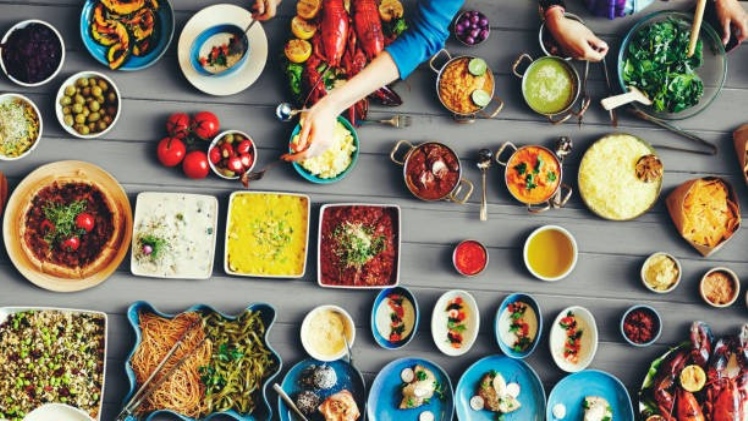which Food is more than just sustenance; it is a universal language that transcends borders, connecting people across cultures and generations. It embodies traditions, memories, and flavors that tell the story of humanity’s rich and diverse culinary history. In this article, we will embark on a culinary journey around the world, exploring the significance of food in different cultures and the delightful flavors that grace our tables.
Section 1: Food as a Cultural Tapestry
Food is a fundamental aspect of culture, reflecting the history, values, and traditions of a community. Here’s how food serves as a cultural tapestry:
1.1. Traditions and Rituals: Food plays a central role in cultural rituals and celebrations, from Thanksgiving feasts in the United States to Lunar New Year banquets in China.
1.2. Culinary Heritage: Traditional recipes and cooking techniques are passed down through generations, preserving the essence of a culture’s cuisine.
1.3. Identity and Pride: Food can be a source of cultural identity and pride, as communities celebrate their culinary heritage.
Section 2: Exploring Global Flavors
Our culinary journey takes us to different corners of the world, where we’ll explore the unique flavors and dishes that define each region.
2.1. Italian Cuisine: The Art of Simplicity
Italian cuisine is celebrated for its simplicity and use of fresh, high-quality ingredients. From the iconic pasta dishes like spaghetti carbonara to the beloved pizza originating from Naples, Italy’s food culture emphasizes the beauty of uncomplicated flavors and techniques.
2.2. Thai Cuisine: A Symphony of Flavors
Thai cuisine is renowned for its harmonious blend of sweet, salty, sour, and spicy flavors. Dishes like Pad Thai and Green Curry are famous for their complexity and balance, showcasing the use of aromatic herbs and spices.
2.3. Indian Cuisine: A Feast for the Senses
Indian cuisine is a kaleidoscope of flavors, colors, and textures. The use of spices like cumin, coriander, and turmeric creates a vibrant and diverse culinary landscape. From the fiery curries of South India to the aromatic biryanis of the North, India’s cuisine is a sensory adventure.
2.4. Japanese Cuisine: Artistry on a Plate
Japanese cuisine is not just about taste; it’s an art form. Sushi, sashimi, and tempura are not only delicious but also beautifully presented. The philosophy of “washoku” (traditional Japanese cuisine) emphasizes balance and harmony in both flavors and aesthetics.
2.5. Mexican Cuisine: A Fiesta of Flavors
Mexican cuisine is a celebration of bold, spicy, and hearty flavors. From tacos to tamales and mole sauces, Mexican dishes are a testament to the country’s agricultural abundance and multicultural influences.
Section 3: The Universal Appeal of Street Food
Street food is a global phenomenon, offering affordable and flavorful bites to locals and travelers alike. Here’s a glimpse into the world of street food:
3.1. Bangkok, Thailand: Pad Thai on Khao San Road
Khao San Road is a bustling hub of street food vendors in Bangkok, where you can savor the authentic flavors of Pad Thai—stir-fried noodles with shrimp, tofu, and aromatic herbs.
3.2. Istanbul, Turkey: Doner Kebab in Taksim Square
Taksim Square in Istanbul is famous for its savory Doner Kebab—spit-roasted meat wrapped in flatbread with fresh vegetables and yogurt sauce.
3.3. Mexico City, Mexico: Tacos at El Parnita
El Parnita is a beloved spot for street tacos in Mexico City. Try the pastor tacos with marinated pork, pineapple, and salsa for a mouthwatering experience.
3.4. Marrakech, Morocco: Moroccan Tagine in the Medina
The bustling medina of Marrakech offers a taste of Morocco’s cuisine with flavorful tagines, slow-cooked stews featuring ingredients like lamb, apricots, and aromatic spices.
Section 4: The Intersection of Food and Health
Food not only pleases our palates but also plays a significant role in our health and well-being. Here’s a look at the intersection of food and health:
4.1. Balanced Nutrition: A balanced diet ensures that our bodies receive essential nutrients for optimal health. It includes a variety of foods such as fruits, vegetables, lean proteins, whole grains, and healthy fats.
4.2. Cultural Diets: Different cultures have their dietary patterns, like the Mediterranean diet, known for its heart-healthy benefits, or the plant-based diets of some Asian communities that contribute to longevity.
4.3. Food as Medicine: Some foods are celebrated for their health benefits, such as turmeric in Indian cuisine, which has anti-inflammatory properties, or the omega-3-rich fish in Japanese diets that support brain health.
4.4. Mindful Eating: The practice of mindful eating encourages us to savor each bite, fostering a healthier relationship with food and promoting mindful choices.


